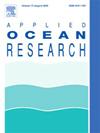Effect of particle crushing on the mechanical behavior of unreinforced and geogrid-reinforced marine coral sands
IF 4.3
2区 工程技术
Q1 ENGINEERING, OCEAN
引用次数: 0
Abstract
Strength deterioration induced by particle crushing is detrimental to the construction of marine geo-structures. As an efficient reinforcement method, the geogrid-reinforced coral sand (GRCS) technique also suffers from the adverse effects of particle crushing. In this study, the macro-micro mechanical behavior of unreinforced and geogrid-reinforced coral sands under triaxial loading was investigated using an experimentally validated three-dimensional discrete element method (DEM), focusing on the effect of particle crushing. The results reveal that crushability determines the stress-strain response, strength parameters, spatial distribution of crushing, and number of particle fragments differently. The analysis of microscopic contact forces indicates that the resistance pattern of GRCS under triaxial loading results in the gap in spatial distribution patterns and the number of fragments compared with the unreinforced condition. Further micro-scale analysis of the crushing behavior shows that the increased fragments induce a transition of the particle morphology from angular to round-like patterns, thus the low occlusion and increased plasticity of crushed coral sands contribute to the stress-strain softening and peak strength reduction. In conjunction with the effect of crushing on shear strength, the strength envelope characteristics and the evolution mechanism of shear mechanical parameters are revealed under the effects of reinforcement, low crushing, and high crushing.
颗粒破碎对未加筋和加筋海洋珊瑚砂力学性能的影响
颗粒破碎引起的强度劣化对海洋土工结构的施工是不利的。作为一种有效的加固方法,土工格栅加筋珊瑚砂(GRCS)技术也面临着颗粒破碎的不利影响。本研究采用三维离散元法(DEM)研究了三轴载荷下未加筋和加筋珊瑚砂的宏观微观力学行为,重点研究了颗粒破碎的影响。结果表明,可破碎性不同程度地决定了应力应变响应、强度参数、破碎空间分布和颗粒破碎数。微观接触力分析表明,三轴加载条件下GRCS的阻力模式导致其空间分布模式和碎片数量与未加筋条件相比出现了差距。进一步的微观尺度破碎行为分析表明,破碎碎片的增加导致颗粒形态由角状转变为圆形,因此破碎后珊瑚砂的低闭塞性和增加的塑性有助于应力-应变软化和峰值强度降低。结合破碎对抗剪强度的影响,揭示了加筋、低破碎和高破碎作用下的强度包络特征和抗剪力学参数的演化机制。
本文章由计算机程序翻译,如有差异,请以英文原文为准。
求助全文
约1分钟内获得全文
求助全文
来源期刊

Applied Ocean Research
地学-工程:大洋
CiteScore
8.70
自引率
7.00%
发文量
316
审稿时长
59 days
期刊介绍:
The aim of Applied Ocean Research is to encourage the submission of papers that advance the state of knowledge in a range of topics relevant to ocean engineering.
 求助内容:
求助内容: 应助结果提醒方式:
应助结果提醒方式:


